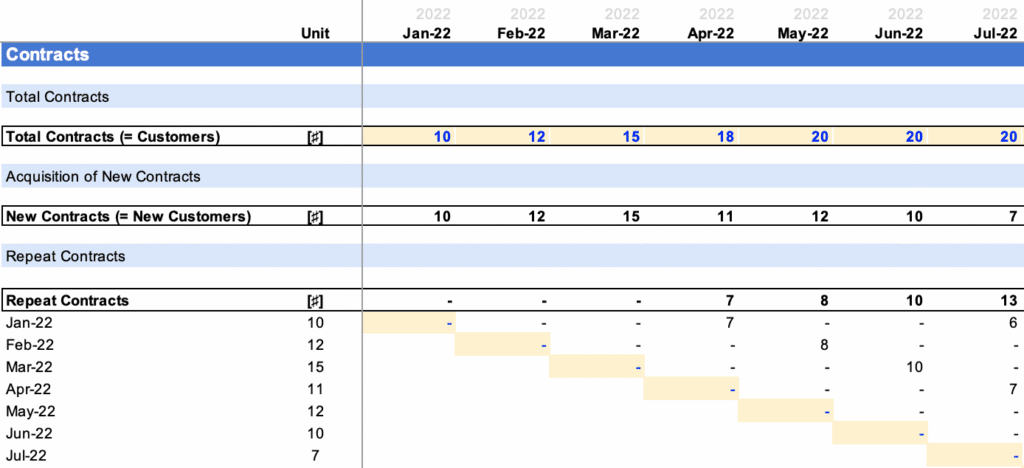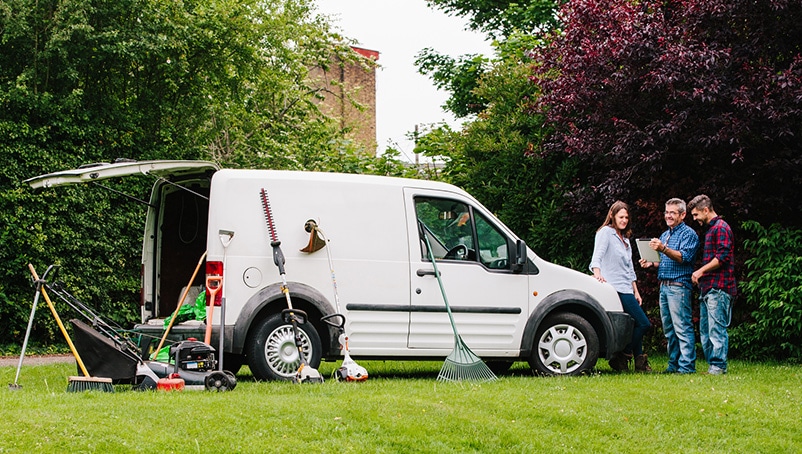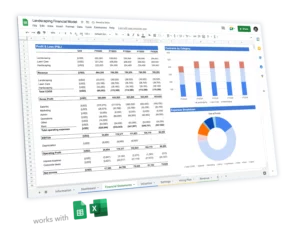How to Build a Financial Model for a Landscaping Business

👇 Check all our resources on landscaping businesses 👇
Every business needs a financial model. Whether you want to understand what’s your breakeven, your valuation or create a financial model for the business plan of your landscaping business, you’ve come the right way.
In this article we’ll explain you how to create powerful and accurate financial projections for a small landscaping company with 4 employees.
Also note that the charts and examples presented in this article come from our landscaping business financial model template.
1. Forecast the Number of Contracts
Like any other service business, the first thing you must do when building financial projections for a landscaping business is to forecast the number of contracts over time.
This is arguably the most challenging part of your financial model, as you will need to forecast customer retention (contracts from repeat customers).
A contract is defined as one landscaping job. Therefore, it can be as simple as a 3 hour lawn mowing job, or a 10 days landscape design job.
Moreover, there are 2 types of contracts: new and repeat contracts:
- New contracts are jobs you are providing only once for a customer (for example, a one-time planting job for an individual, i.e. 1 new contract)
- Repeat contracts, instead, are jobs that you provide a number of times for the same customer. For example, you could have signed an agreement with a corporate office to provide them with landscaping services 2 times per month
Total Contracts = New Contracts + Repeat Contracts
Naturally, the number of contracts you can perform is constrained by your capacity: the number of landscaping workers you have and the length of each contract (short vs. long-term landscaping jobs).
Total Contracts
The first thing you must do is set the number of contracts you expect to do over time. We suggest you do this month by month. For example, you could have:
- January 2022: 10 contracts
- February 2022: 12 contracts
- March 2022: 15 contracts; etc.
Note: we assume here you start your business in January and increase the number of contracts over time as you acquire new customers
Repeat Contracts
Now that we have set the number of contracts you can perform over time, let’s forecast New vs. Repeat Contracts, starting with the latter.
In order to forecast repeat contracts, you will need to set 3 assumptions:
- The percentage of customers that are repeat. For example 70% of your customers ask for regular landscaping jobs
- The number of contracts per year per repeat customer. For example, you provide on average 4 contracts per year for each repeat customer i.e. once every quarter
- The annual churn of repeat customers. Unfortunately repeat customers will churn over time (for example, a customer leaving after 5 years churn at 20% per year)

This will allow you to forecast repeat contracts over time as shown below (note we are using a cohort model):

New Contracts
Now that we have calculated Repeat Contracts over time, and set Total Contracts, New Contracts can easily be obtained using the following equation:
New Contracts = Total Contracts – Repeat Contracts

Finally, you can show the number of contracts over time, both from new and repeat customers (see chart below).
Note that the number of new customers’ contracts is much lower vs. repeat customers as you are constrained by your capacity. What happens in reality indeed is that you can’t take on more new customers contracts unless you hire more employees..!
In the example below, we take the example of a landscaping company focusing on business customers with regular jobs. On average, 70% of all customers are repeat jobs: they need on average 1 job per quarter.


2. Calculate Revenue
Now that we have forecasted the number of contracts over time, we can now calculate revenue.
This can be done by segmenting the number of contracts by different type of jobs. Each job will have different rates and associated costs.
We recommend setting a table like the one below:

In the example above, we assume that, if we have 100 contracts (in a month for example), we will perform:
- 10 landscape design jobs priced at $2,200 each
- 15 landscape design jobs priced at $1,250 each
- 10 landscape design jobs priced at $850 each
- etc.
That way, you can obtain revenue projections by the type of contract (for example landscaping, lawn care and hardscaping):

3. Forecast Expenses
The 3rd step of our landscaping financial model is forecasting expenses.
In addition to the startup costs discussed here, there are a number of recurring (or “operating”) costs that any landscaping business must account for.
We have laid out below an example of operating expenses for a standard landscaping business with 4 employees: you would pay around $20,700 – $33,000 per month to run the business.
| Operating cost | Amount (per month) |
|---|---|
| Staff | $12,000 – $20,000 |
| Fuel | $3,200 – $4,500 |
| Rent | $4,500 – $5,000 |
| Repair & maintenance | $500 – $1,500 |
| Marketing | $500 – $2,000 |
| Total | $20,700 – $33,000 |
Staff
The total cost for your staff will largely depend on the number of employees you have, as well as the types of services you offer (for example, if you hire a landscape architect or not).
You would want the assistance of the following experts to launch a typical landscaping business on a large scale:
- Manager (Owner)
- Landscape Architect/Landscapist (optional)
- Field Staff
- Front Desk Officer (optional)
- Human Resources / Office Manager (optional)
- Marketing and Sales Executive (optional)
On average, a landscaping worker can expect to receive $22,800 to $48,300 per year depending on experience. Assuming you run a business with 4 employees (including yourself) at an average salary of $35,000 per year, you would be spending around $14,000 per month in wages.

Fuel
Unfortunately, landscaping is very dependent upon fuel.
You’ll be on the road as a lawn professional going from one job to the next. Many professionals travel considerable distances outside their immediate area to complete jobs.
You might easily spend several hundred dollars a month on gas, particularly if you use heavy machinery and huge trucks. Creating efficient routes and locating reasonably fuel-efficient trucks are two ways to lower this expense.
But fuel isn’t just about travel costs from one client to another, it’s mostly about the cost to run the machines (heavy machines, lawnmower, etc.).
Your lawnmower and other gas-powered equipment will also require gasoline. A gas-powered mower uses around $7 worth of fuel every hour. Assuming you use it 4 hours a day, 5 days a week, that’s $560 worth of gas per month just for one mower..! Assuming you have 4 employees, each using a gas-powered mover for 4 hours a day (assuming that’s the only gas-powered machine they use), that’s a total of $2,000 per month minimum.
Now, let’s add travel costs.
Let’s assume you run a landscaping business with 2 small vans traveling each 50 miles per day (consuming 8 to 10 miles per gallon) at $4.50 per gallon. You would be spending over $600 in gas per month per van, so $1,200 total minimum.
You do the math: fuel costs would be anywhere from $3,200 to $4,500 per month for such a business.

Rent
Rent expense depend whether you run a small or a large scale landscaping business. In other words, how many pieces of equipments and machines you need to store, and whether you have a separate office to run administrative tasks (finance, human resources) and welcome clients.
Suppose you run a small landscaping business, you may decide to rent a storage space. The average monthly cost for portable storage units (like PODS) is $150. Self-storage facility units are reasonably cheap, costing about $90 per month, while larger units can run up to $300 per month.
Instead, if you run a large-scale landscaping business, you might want to rent an office and a storage / warehouse unit. Assuming you rent a 2,500 sq. ft. office and warehouse at a rate of $20 per sq. ft. per year, you’ll be paying around $4,000 in rent. Adding up utility bills, you should budget for $4,500 to $5,000 per month.
Equipment Maintenance
Daily equipment maintenance is usually not very expensive, but repair expenses are common and must be budgeted for. Typically, a mower repair costs between $60 and $100.
Of course, small repairs can be done by yourself, but for large-scale landscaping businesses with heavy machinery, you’ll likely pay a $500 to $1,000 annual fee so the manufacturer can take care of the maintenance, repair (and free replacement) of your equipment.
4. Build P&L and Cash Flow
Once we have estimated revenues, expenses and debt, we can easily build the profit-and-loss (P&L) from revenues down to net profit. This will help you to visualise key financial metrics such as Gross Profit or EBITDA margin as shown below:

The cash flow statement, in comparison, needs to include all cash items from the P&L and other cash movements such as capital investments (also referred as “Capex”), fundraising, debt, etc.
Cash flow is vital as it will help you understand how much funding you should get, either from investors or the bank (SBA loan for example) to start and run your own landscaping company, which we do in our financial model template with the use of funds chart (see below).
In this chart, we’re showing you the example of a cost structure a typical landscaping business would have (including the upfront costs, for example, to purchase the equipment and vehicles).
Unsurprisingly, salaries make up ~60% of total expenses: like any other service business, landscaping have indeed very little fixed costs apart from payroll.




